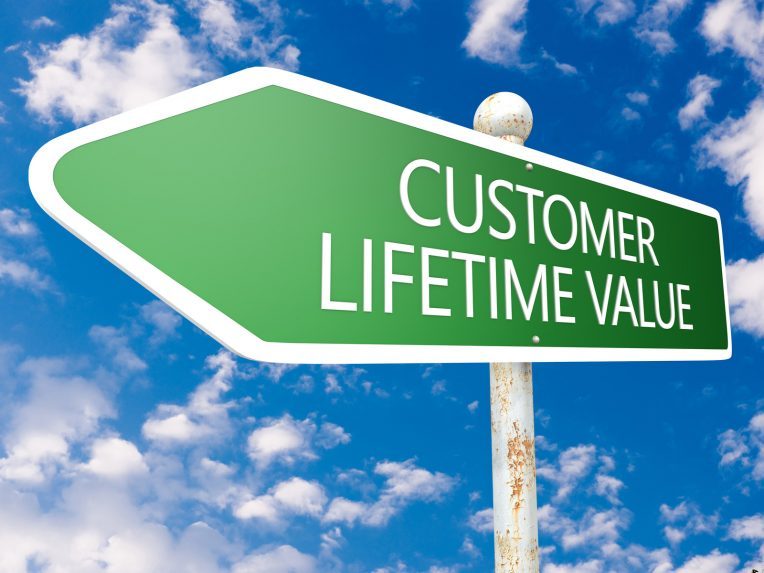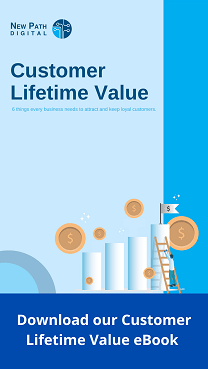One key metric small business owners should keeping an eye on is Customer Lifetime Value (LTV or LTV). This measure helps you understand customer loyalty and value customers bring to your business over an extended period.
Lifetime Value (LTV) measures how much a customer is worth to your business over the whole period of your relationship with them. It isn’t their first sale, or their most recent. It is the sum of every purchase they ever made with you – or every purchase you can expect from them.
Ideally it is calculated based on profit rather than revenue, which takes into account the cost to acquire customers, (that is marketing costs) and customer service costs (front line staff, rent etc).
One benefit of tracking LTV is that it can give you guidance on what parts of your marketing are delivering better long term value.
For example, if the customers on your email newsletter list have a higher LTV than those who find you through Facebook, you might put some more effort and money into your email marketing.
Alternatively, customers from one postcode might be worth more to you than another – you can focus your marketing in this location to find more like them.
I believe to really understand if customers are engaging with your business and staying loyal, Lifetime Value is the key metric to measure.
How to measure Lifetime Value – historic v predictive.
There are multiple ways to calculate LTV. Most calculations are defined as Historical or Predictive. The data you have available and the type of business you’re in will determine which works best for you.
You can calculate LTV at multiple levels across your customer base:
- Individually for each customer
- As an average across groups of customers for example by postcode, or the length of time they have been a customer
- As an average across all customers.
It is useful to do all three so you can compare.
Historical LTV:
Historical LTV is the customer’s lifetime value to date. It measures the total profits from a customer’s first purchase until their most recent.
Historical LTV = Total Revenue x Average Gross Margin.
Calculate this for every customer, then calculate the average by segment and total business average.
For example:
A sporting goods retailer who sells a variety of outdoor sports equipment. Has and average sales revenue across their customer base of $1,302 and Average Gross Margin of 10%.
LTV = $1,302 x 10% = $130.20
The individual LTV of their customers are:
Customer | Total Sales | LTV (10%) |
Sally | $ 1,506.00 | $ 150.60 |
Mike | $ 1,370.00 | $ 137.00 |
Tom | $ 556.00 | $ 55.60 |
Jane | $ 220.00 | $ 22.00 |
Rudi | $ 2,460.00 | $ 246.00 |
Anton | $ 80.00 | $ 8.00 |
Claire | $ 1,480.00 | $ 148.00 |
Jonas | $ 3,589.00 | $ 358.90 |
Pat | $ 678.00 | $ 67.80 |
Blair | $ 1,088.00 | $ 108.80 |
Average | $ 1,302.70 | $ 130.27 |
Looking at this data, Rudi is a valuable customer who should be nurtured. Anton looks like someone who is not as loyal, but maybe has the potential, but should be treated differently to Rudi.
Predictive LTV:
Predictive LTV is the amount you expect customers to spend over their entire relationship with you.
Predictive LTV = Average Purchase Value x Number of Purchases per Year x Average Customer Lifespan in Years x Average Gross Margin
Note: you can adjust the purchase frequency depending on what is appropriate for your business.
Once you have this calculation, you need to monitor a couple of things:
- Customer’s actual spend against predicted LTV – are they on track to what you predicted?
- LTV trend over time – are people spending more, or less with you?
For example, for a gym owner with a monthly membership fee of $79, an average customer lifespan of 6.5 years and average gross margin of 12% the predictive LTV is:
$79 x 12 x 6.5 x 12% = $739.44
Chart: Bell curve of Low, Medium, High LTV customers
Another way to look at LTV is in the following chart.

The longer your relationship with a customer, the more profitable they should be for you. The 20% of customers who have been with you the longest, who purchase again and again will be delivering the most value to your business. When you know who these customers are, you can treat them like the VIPs they are to your business.
In the middle, you have about 60% of your customers. They are profitable customers, who have bought from you a few times. You are building a loyal relationship with them. When you know who these people are, you can nurture them differently to your VIPs to encourage them to become your advocates.
The final 20% are most likely new to your business, they have only purchased once or twice. Your lapsed customers could also sit in this group. For the new ones, you’re on the start of the journey with them and you need to think carefully about how to stay connected and build their trust so that over time they move to the right of the chart.
To maximise Lifetime Value in a small business there are 6 principles to follow:
- Know your Customer
- Understand their Journey
- Provide relevant Content
- Use multiple Touchpoints
- Collect useful Data
- Install efficient Systems
If you would like to know more about ways to increase the Lifetime Value of your customers, join our Facebook Group – Digital Marketing for Bricks and Mortar Businesses. Use this forum to ask questions and receive regular updates on how to grow your business through digital marketing.



